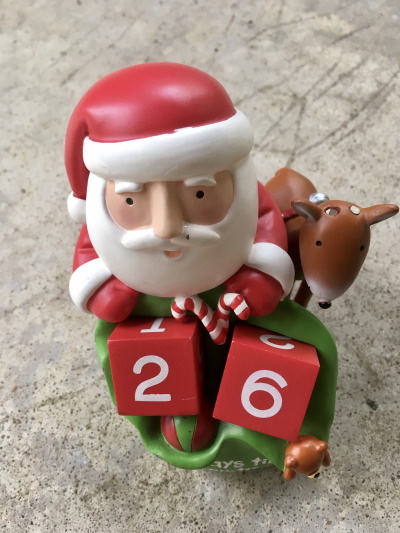Cubic calendars
Suppose you're tasked with designing a Christmas countdown figure that uses numbered cube faces.

How would you put the numbers on the cubes?
Suppose you want the calendar to say 00" on Christmas Day. If we were accustomed to counting in base six, you could label the sides of each cube 0 through 5, and you could count up to 55six = 35ten days until Christmas. But let's work in base 10 like nearly all humans do.
We would at least like to count to 24 so we could start using our calendar on December 1. But to count up to 24, we have to get past 22. That means we have to represent 00, 11, and 22, and that means we have to put a 0, 1, and 2 on each cube. But then we have six remaining faces to receive seven remaining digits, so we can't get past 22.
Here's where we break our implicit rules. We've tacitly assumed each face of each cube has only one label. But since a 6' is an upside-down 9', we can effectively put seven labels on six faces. One cube, call it cube A, can be labeled 0, 1, 2, 3, 4, and 5, and the other, call it cube B, can be labeled 0, 1, 2, 6 (9), 7, and 8.
We can put cube B first on 0, and use cube A to count up to 5. Then we put cube A first on 0 and use cube B to count from 6 up to 9 (upside-down 6). We can do the analogous procedure for leading digits 1 and 2 to count all the way up to 29. To count any further we have to put cube A first with 3 showing because that's the only way to get a number in the 30s. We can count up to 32, then we're stuck.
We could break another implicit rule. We've assumed there must be two digits. What if we're content to have a single 0 on Christmas Day and represent single digits by not using a cube in the first slot? Now only one cube has to have a 0 on it.
I don't think this helps. To get past 32, we need a 3 on both cubes. We already have a 3 on cube A, but if we replace the 0 on cube B with a 3, now we can't represent 10 or 20.
So it seems 32 is as high as we can count without thinking of another rule to bend.
Exercise for the reader: How many consecutive numbers could you produce using octahedra rather than cubes? Since the sides of octahedra are triangles, not cubes, you might argue that the faces should be oriented with the base of the triangle on bottom and so the trick of using an upside-down 6 to represent 9 should be disallowed.
The post Cubic calendars first appeared on John D. Cook.